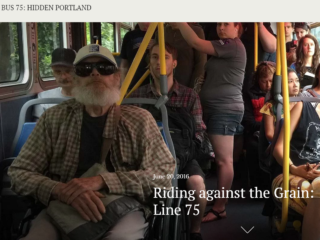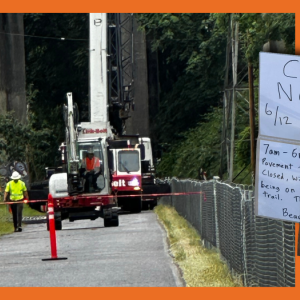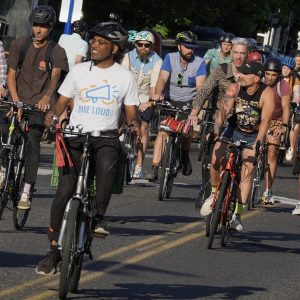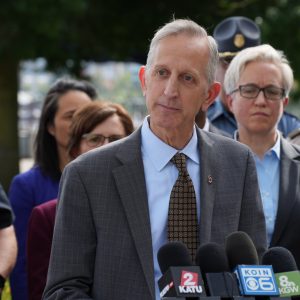
We don’t often publish transit-only posts, but we’ll make an exception for this one.
Portland-based photographer Geoffrey Hiller is working on an all-year project to document the life of Portland through the lens of a single bus line: the No. 75 that runs between Milwaukie and St. Johns via Chavez, 42nd and Lombard.
For a post yesterday, he recruited Portland-based transit consultant and writer Jarrett Walker (who happened to be a teenage intern at TriMet in the 1980s, when the 75 bus was created) to write about the ways the 75 reveals this moment in Portland’s ebbing, flowing life.
The result is a short illustrated essay that is, somehow, both about our city and about good public transit network design. It’s something to behold:
Advertisement
Distance from the center has always been a statement about power, even if its significance has flipped every 50 years. In the 1960s, when power and wealth were fleeing the city, a five-digit house number meant you were remote and secure, while the historic inner city (except for a few enclaves) meant abandonment and crime. But the 2010s are more like the 1910s. A century ago, confident money built the fine Victorian and Craftsman homes of the inner city. Today, again, money rushes inward, pricing the inner city out of the reach of the artists and working people (including my own parents) who made it so interesting fifty years ago.
The marks of this pulsing oscillation are brutally obvious if you go inward or outward, but if you follow an orbital path, as the 75 does, you encounter more subtlety. History and power flow across the 75 more than along it, but as they do they surge and eddy in fractal patterns, even as a few rocks standing firm against their current.
It’s short. It mentions the Springwater Trail at one point. Just read it.
— Michael Andersen, (503) 333-7824 – michael@bikeportland.org
Our work is supported by subscribers. Please become one today.






Thanks for reading.
BikePortland has served this community with independent community journalism since 2005. We rely on subscriptions from readers like you to survive. Your financial support is vital in keeping this valuable resource alive and well.
Please subscribe today to strengthen and expand our work.
Now a five digit house number means you’ve been forced out of the inner city via greed and gentrification.
In his post, he says that the 75 is the busiest orbital route… but I could have sworn the busiest is the 72. Does anyone know where to find new ridership statistics?
I usually ride the 75 a few times a week and the 72 once or twice a week and the 75 is never as full as the 72.
Personally, I feel like the 75 is one of (if not the) best route for a MAX line that doesn’t go downtown. It would connect all of the MAX lines to each other, and it would be great for N/S trips on the Eastside and E/W trips on the North side.
Yeah, I don’t know about that claim – I haven’t looked at the numbers for a few years but I’d be surprised if the 75 gets more boardings than the 4 or the 72, even on a per-stop basis.
Ridership stats by line are available only via TriMet public records request, but anyone can file one.
Any chance you’d like to file another one? I really missed that feature from your Portland Afoot operation.
Thanks! I get queries about it every now and then so I’m sometimes tempted to do another just for fun. If you can believe it, those were a major revenue center for PA … and funded by ODOT! It was a strange little operation.
“Only on the Bus!” Loved that feature. Even read it on the bus once.
According to Metro the busiest bus lines (by total ridership) are the 4, 72, 20* and 75, in that order:
http://www.oregonmetro.gov/news/you-are-here-snapshot-how-portland-region-gets-around
*Line 20 isn’t even frequent service, but I believe that there are plans to change that.
Yeah, but that would mean a MAX line designed for the benefit of Portlanders and not suburban commuters.
I’ve had the opposite problem more often (waiting for a SB 75 while 2 or 3 NB go by). I think the timing is hard, especially since there’s no bus priority anywhere along the route (IIRC). If there were more bus priority (or bus lanes) on 39th, I think the route would be much more reliable.
The 75 bus should be converted to a MAX line.
In hopes of speeding it up?
It’s definitely slow, but the stop reduction that MAX brings would have negative impacts as well.
Not a bad idea in theory, but this region isn’t even willing to pay for a tunnel to directly serve the city’s largest employer. There is no way a crosstown MAX line that will require significant sections of tunnel will ever be a regional priority (elevated is a complete non-starter).
It wouldn’t require a tunnel if the route were slightly changed and if parking were removed.
For example, rather than detouring to Dekum, it could stay on Lombard. Rather than going down 42nd, it could go down 33rd and avoid all of the tight turns. However, I’m not sure what would happen at the Southern end of the line, but I’m pretty sure there are a few solutions that don’t involve a tunnel.
BRT would be a good fit, but it would be a major project, as 39th would need to be redesigned with 5 lanes (BRT, general, turn, general, BRT). Lombard is already overbuilt and has space for BRT lanes.
MAX priority should be as follows:
– SW Corridor
– Powell line in to 205 and re-routing of green line to relieve Steel Bridge
– Yellow line extension to Vancouver
– Division line from 205 to Gresham
– Tunnel to supplement Steel Bridge bottleneck
Then we can start talking about cross-town routes. A spur off of the yellow line down Lombard would make sense as a first phase. Building the rest of it is not easy.
A Lombard spur is such a good concept with very few issues, yet I don’t see it in any planning documents.
Well, there probably isn’t the ridership to support such a line, because the peninsula lacks the population and employment density (that could easily be served by fixed-guideway transit), and there isn’t a huge park-and-ride market from Scappoose or St. Helens that would park at a St. Johns terminus. Transit agencies often rely on these park and riders to pump up ridership numbers when competing for federal funds.
Also, if you branch the Yellow Line at Lombard, you are halving the frequency on both spurs, meaning 30 minute minimum headways on the St. Johns and Expo Center branches. Yellow Line frequency cannot be increased unless improvements are made to the Steel Bridge to increase maximum speeds on the bridge which would increase per-hour train throughput (or unless a new river crossing is built). The Columbia River Crossing plan would have included such improvements to the Steel Bridge, by the way.
What improvements would the CRC have made to the Steel Bridge?
Also, a good way to increase frequency (and do without the SB bottleneck) would be to run from St. Johns to IRQ, then continue South to the Orange Line at between OMSI and Clinton. Sure, it would be fairly expensive, but it would allow people to connect N/S without going through downtown or transferring to a slower mode of transportation.
From page 2-29 of the CRC FEIS:
Currently, all light rail transit lines within the regional MAX system cross the Willamette River in downtown Portland via the Steel Bridge. The Steel Bridge was built in 1912 and was retrofitted in 1984 to receive LRVs. When the first light rail line opened in 1986, 40 LRVs crossed the bridge during the 4-hour PM peak period; in 2007, with the Red and Yellow Lines opened, 116 LRVs crossed the bridge during the 4-hour PM peak period. In 2009, TriMet opened the I-205 South Corridor Project, increasing the number of vehicles that cross the Steel Bridge to 152 during the 4-hour PM peak period. With a “peak of the peak” headway of 7.5 minutes, the CRC project would increase the number of LRVs that cross the Steel Bridge in 2030 during the 4-hour PM peak period to 176 trains. To accommodate these additional trains, the CRC project would retrofit the existing rails on the Steel Bridge to increase the allowed light rail transit speed over the bridge, increasing the LRV throughput of the bridge.
The Steel Bridge has a lift span that requires lift joints in the MAX rails within the track bed. These lift joints limit the crossing speed of LRVs to no more than 10 miles per hour (mph). This limitation is because the vibrations at these joints disrupt the signaling and electrification system. Modifications to reduce the wheel rise from the lift joint would decrease the bridge vibration, allowing MAX trains a maximum speed of 15 mph on the Steel Bridge, thus improving the speed of all MAX lines crossing the bridge. There is also an existing signal case on the lift span that cannot withstand high levels of vibration. The overhead catenary system (OCS) that supplies electrical power to the trains is also not designed to withstand the high levels of vibration that are generated with speeds above 10 mph.
I imagine that could be done much cheaper than the billions of dollars it would take to finance a bridge for Washington commuters.
And I would say that the peninsula has plenty of people and jobs. 3 times more than Forest Grove, which is on the HCT plan.
That’s why I listed the Lombard Spur after a new downtown tunnel to supplement the Steel. It would be a new line that would share tracks with Yellow between downtown and Lombard. Similarly to what we saw along N Interstate, proper zoning changes and fixed transit on Lombard would spur dense development.
Blue Line into Washington?
Typically BRT is built center-running and left turns are banned. We’d only need four lanes for that.
You need space for the island stations, at least. And the lanes on 39th are already fairly, narrow.
Here’s an idea: Make 39th one-way for cars NB and make 82nd one-way for cars SB. Then you have plenty of room for much bigger sidewalks and full BRT.
A 43 block separated couplet? How . . . infeasible.
I loved this essay. Thanks for highlighting it here.
On the subject of transit blogging: where do people go for Portland transit info now? The PortlandTransport blog is essentially defunct. I think I get more info about Portland transit from this blog and SeattleTransitBlog.
I really miss Portland Transport. There is so much going on right now (TSP update including Central City 2035, Powell-Division, SW Corridor, parking meters in NW / CEID, TriMet Service Enhancement Plans, etc) that it’s a shame that we don’t have a news source covering those stories in detail.
Thanks for volunteering, gentlemen.
I honestly would, but my availability is sporadic, I spend too much time travelling and I honestly don’t know enough about transit.
Second what Jessica said. Thanks, Michael. PS: I miss Portland Afoot.
Thanks for the essay. I kept looking for the photos. Need about six more to get a good feel for what the words were trying say.
A book inspired by the riding almost the entire length on the 75 line for years.
https://www.amazon.com/Mass-Transportation-Scott-Tienken/dp/1257959298?ie=UTF8&*Version*=1&*entries*=0
OMG that drove me crazy!